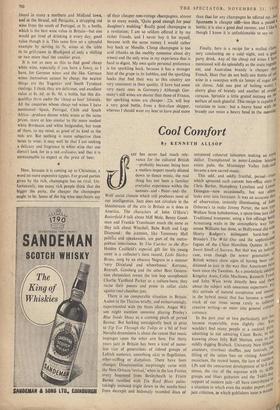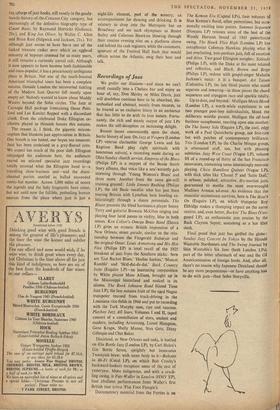Cool Comfort
By KENNETH ALLSOP AZZ has never had much rele- vance for the cultured British ---probably because, being here a rootless import mostly diluted down to dance music, the real thing has not been a familiar everyday experience within the nannies - and - Peter - and - the Wolf social climate which still produces most of our intelligentsia. Jazz does not circulate in the bloodstream of the arts in Britain as it does in America. The characters of John O'Hara's Butterfield 8 talk about Miff Mole, Benny Good-. man and Frankie Trumbauer much the same as they talk about Winchell, Babe Ruth and Legs Diamond : the jazzmen, like Tammany Hall politics and speakeasies, are part of the metro- politan inheiitance. In The Catcher in the Rye, Holden Caulfield's' especial gift for his young sister is. ,a collector's item. record, Little Shirley Beans, sung by an obscure Negress in a manner 'very Dixieland and whorehouse.' Kerouac, Rexroth, Ginsberg and the other Beat Genera- tion chroniclers revere the late bop saxophonist Charlie Yardbird Parker as a culture-hero; they recite their poems and prose in cellar clubs against cool chamber jazz.
There is no comparable situation in Britain.' Auden in the Thirties briefly, and embarrassingly, experimented with the blues idiom. Angus Wil- son might mention someone playing Presley's Blue Suede Shoes as a cunning pinch of period flavour. But harking nostalgically back in print. to Tip Toe Through the Tulips or a bit of Ivor Novello dreaminess is about the extent that music impinges upon the other arts here. For thirty years jazz in Britain has been a kind of name- less vice of generations of inbred groups of Leftish esoterics, something akin to flagellation, ether-sniffing or diabolism. There have been 'changes. Dissemination surprisingly came with the New Orleans 'revival,' when in the late Forties. every, basement from Bexleyheath to Friern Barnet rumbled with Tin Roof Blues pains- takingly imitated (right down to the needle-hiss) from decrepit and hideously recorded discs of untutored coloured labourers making an extra dollar. Transplanted to outer-London housing estate pubs, the Mississippi Valley folk-stuff became a new sacred music.
This odd, and oddly fruitful, period—from which sprouted such current box-office stars as Chris Barber, Humphrey Lyttelton and Lonnie Donegan—now occasionally, but not often' leaks over into literature. It was an accurate shot of observation, instantly illuminating, of John Osborne's to make Jimmy Porter, the new type Welfare State hobohemian, a spare-time jazz Cltih Traditional trumpeter, using a few offstage beefy Armstrong wails in the atmospheric way nessee Williams has done, as Hollywood did Wit Shorty .Rodgers's delinquent hard-bop in, Brando's The Wild One and the sophisticate' fugues of the Chico Hamilton Quintet in Tile Sweet Smell of Success. But that was an isolated case, even though the newer generation of British writers show signs of having been o°11' ditioned to jazz in the way that Americans have been since the Twenties. As a journalistic sideline Kingsley Amis, Colin Maclnnes, Kenneth Tynan, and John Wain write directly here and there about the subject with unearnest expertness. let this attitude of natural acceptance and interest in the hybrid music that has become a small' track of our times seems rarely to illfilteelej creative writing—or enter into general culture currency. In the past year or two particularly jazz haus become respectable, even slightly chic. Yn„ wouldn't find many people at a cocktail ['atlt admitting to not admiring Count Basle, to 00t knowing about, Jelly Roll Morton, even to not mildly digging Brubeck. University New Orleans amateurs, riverboat shuffles, jazz festivals.% lifting of the union ban on visiting AnlerIcag, musicians, the record boom, the lure of ralilb° hi-fi an LPs and the concurrent development of h.-- n.,fle stereo, the rise of the espresso with its sl`ii", groups and blues guitarists and the TeddY.h°)0 t support of modern jazz—all have contributed a situation in which even the staider papers Writ; jazz criticism, in which publishers issue a m°13 ing splurge of jazz books, still mostly in the gaudy- bawdy-history-of-the-Crescent-City category, but increasingly of the definitive biography type of Count Basle, by Raymond Horricks (Gollancz, 21s.), and King Joe Oliver, by Walter C. Allen and Brian Rust (Sidgwick and Jackson, 21s.). Yet although jazz seems to have burst out of the locked treasure casket over which an egghead minority of hepsters crooned for so many years, it still remains a curiously unreal cult. Although it now appears to have become both fashionable and mass-popular, it has a precariously ambiguous place in Britain. Not one of the much-boosted American' triumphal tours has been a complete success. Outside London the introverted tinkling of the Modern Jazz Quartet fell mostly upon empty air. Nobody wanted to know about Muddy Waters beyond the Soho circles. The Jazz at Carnegie Hall package (containing Oscar Petti- ford and Lee Konitz) flopped with a discordant clunk. Even the celebrated Duke Ellington or- chestra played to thinnish houses this autumn.
The reason is, I think, the gigantic miscon- ception that blankets jazz appreciation in Britain. Our breath is too baited, our hopes too innocent. Jazz has been enshrined in a grey-flannel robe. We expect too much of the poor slob. Ellington misjudged his audiences here, the audiences reared on selected specialist jazz recordings totally misread what the Ellington band is—a travelling show-business unit—and the disen- chanted purists snarled as ballad succeeded comic-hat number. Across 3,000 miles of ocean the legends and the holy fragments have come, but not until now the fallible, potboiling human sources from the place where jazz is just a night-life element, part of the scenery, an accompaniment for dancing and drinking. It is salutary to drop into the Metropole bar on Broadway and see such olympians as Buster Bailey and Coleman Hawkins blowing through their routine evening stint on a platform above and behind the cash registers; while the customers, ignorant of the Festival Hall hush that would obtain across the Atlantic, swig their beer and talk.
Recordings of Jazz
We prefer our illusions—and since we can't stroll casually into a Chelsea bar and enjoy an hour of, say, Don Shirley or Miles Davis, jazz will doubtless continue here to be absorbed, dis- embodied and abstract, mostly from records, to be treated as an exclusive litany in an ambience that has little to do with its true nature. Fortu- nately, the rich and steady output of jazz LPs makes the self-deception an increasing delight.
Recent issues conveniently span the short, hectic history of jazz. On Jazz at Vespers (London LP) veteran clarinettist George Lewis and his Ragtime Band play eight spirituals with boisterous naiveté, a recording made during an Ohio Sunday church service. Empress of the Blues (Philips EP) is a snippet of the Bessie Smith Story albums, that voice like a sou'-westerly gale storming through 'Young Woman's Blues' and three more. Another from the same gin-mill training ground : Little Jimmie Rushing (Philips LP), the old Basie vocalist who has just been touring Britain with Lyttelton here bawling ex- hilaratingly through a dozen perennials., The Bluest presents the blind harmonica-player Sonny Terry and guitarist Brownie McGhee singing and playing four lurid pans to virility, blue in both senses. Ken Colyer's Omega Brass Band (Decca LP) gives an ecstatic British impression of a New Orleans street parade, similar to the rela- tionship between the Fitzgerald Rubaiyat and the original Omar. Louis Armstrong and His Hot Five (Philips EP) is total recall of the 1925 breakout of jazz from the Southern sticks : here are 'Gut Bucket Blues,' Heebid Jeebies,"Muscat Ramble' and `Skid-dat-de-dat.' Back Country Suite (Esquire LP)—an Interesting composition by White pianist Mose Allison, brought up in the Mississippi hinterland and soaked in its idioms. The Bunk Johnson Band (Good Time Jazz LP), the late autumn fruit of the aged Negro trumpeter rescued from truck-driving in the Louisiana rice-fields in 1944 and put to recording with the Turk Murphy men, ripe and raucous. Playboy Jazz All Stars, Volumes I and II, taped concert of a constellation of stars, ancient and modern, including Armstrong, Lionel Hampton, Gene Krupa, Shelly Manne, Stan Getz, Dizzy Gillespie and Chet Baker.
Dixieland, or New Orleans and soda, is bottled on Gin Bottle Jazz (London LP), by Carl Halen's Gin Bottle Seven, sprightly but innocuous Twentyish brew; with more body to it—Bobcats in Hi-Fi (Coral LP), on which Bob Crosby's backward-lookers recapture some of the zest of yesteryear. More indigenous, and with a crack- ling swing, is Fats Waller in London (HMV EP), four ebullient performances from Waller's first British tour (circa 'Flat Foot Floogie').
Documentary material from the Forties is on The Kenton Era (Capital LPs), four volumes of Stan Kenton's florid, often pretentious, but occa- sionally exciting tone poems. Summer Sequence (Fontana LP) reissues some of the best of the Woody Herman brand of 1945 powerhouse swing. The Hawk Flies High (London LP) has saxophonist Coleman Hawkins playing what is just everlasting, non-partisan jazz, full of emotion and drive. Two good Ellington samples : Solitude (Philips LP), with the Duke at his most relaxed and reflective, and Black, Brown and Beige (Philips LP), redone with gospel-singer Mahalia Jackson's voice : it is a banquet. Art Tatum (Columbia LP), the late blind pianist who stood separate and towering—in these pieces the chord sequences and arpeggios race and sparkle tidally.
Up to date, and beyond : Mulligan Meets Monk (London LP), a worth-while experiment to see two younger post-bop individualists, Monk the deliberate weirdie pianist, Mulligan the off-beat baritone saxophonist, reacting upon one another. On The Sunny Side (Esquire LP), the cool, edgy work of a Paul Quinichette group, not first-rate but with patches of contemporary brilliance. Trio (London LP), by the Charlie Mingus group, is attenuated stuff, too, but with pleasing subtleties. Jazz West Coast (Vogue LP), volume III of a round-up of thirty of the San Francisco innovators, containing some interestingly neurotic playing. Chico Hamilton Quintet (Vogue LP), with slick titles like 'Chanel 5' and 'Satin Doll,' is urbane, polished, attractive, dry-martini jazz, guaranteed to soothe the most overwrought Madison Avenue ad-man. As evidence that the muscular mainstream survives, here is The Heat's On (Esquire LP), on which trumpeter Roy Eldridge makes a thumping impact on the nerve centres, and, even better, Buckin' The Blues (Van- guard LP), an enthusiastic jam session by the Buck Clayton Septet, sustaining as a hot fillet steak.
Final proof that jazz has girdled the globe: Sunday Jazz Concert In Tokyo by the Hiroshi Wantable Stardusters and The Swing Journal by Shin Wantable's Six Joes (both London LPs), part of the bitter aftermath of war and the 01 Americanisation of foreign lands. And, after all, there's no reason why Japanese Dixieland should be any more preposterous—or have anything less to do with jazz—than Soho Storyville.















































































 Previous page
Previous page